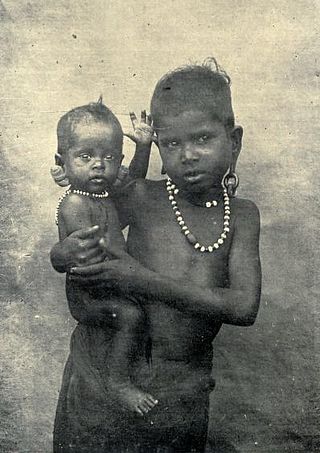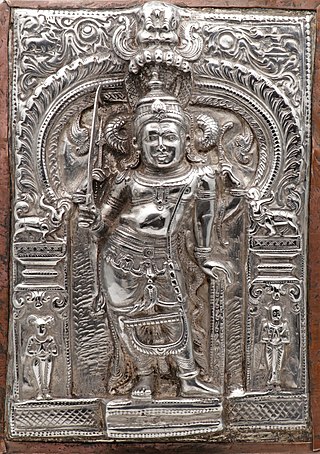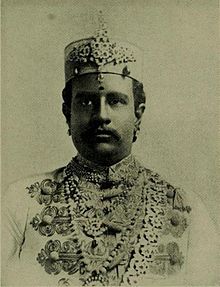
The Nagarathar is a Tamil caste found native in Tamil Nadu, India. They are a mercantile community who are traditionally involved in commerce, banking and money lending.
Mudaliar is a Tamil title and surname. As title, it was historically given to high-ranking military officers and their descendants during the Chola empire rule. The surname is most prevalent among Tamils from Tamil Nadu and Sri Lanka. Descendants of Tamil colonial migrants also bears variants of the name in countries such as South Africa, and elsewhere in the Tamil diaspora.
Saliya or Saliyar is a South Indian Hindu caste. Their traditional occupation was that of weaving and they are found mostly in the regions of northern Kerala, southern coastal Karnataka, Andhra Pradesh, Tamil Nadu as well as Maharashtra and Madhya Pradesh.
Devanga is a Hindu caste from South India that traditionally followed the occupation of textile merchandise, weaving and farming mostly found in the Indian states of Karnataka, Kerala, Andhra Pradesh, Tamil Nadu and Odisha.
Kongu Vellalar is a community found in the Kongu region of Tamil Nadu, India.
Nayaka dynasties emerged during the Kakatiya dynasty and the Vijayanagara Empire period. The Nayakas were originally military governors under the Vijayanagara Empire. After the battle of Talikota, several of them declared themselves independent.

Agamudayar are a Tamil community found in the Indian state of Tamil Nadu. In Southern parts of Tamil Nadu, they are considered as one of the three castes which make up the Mukkulathor community. According to the anthropologist Zoe E Headley, the three communities are the "numerically dominant rural backward castes of the southern districts of Tamil Nadu". Agamudayars are listed in the national commission of backward caste lists for Tamil Nadu as ‘Agamudayar including Thozhu or Thuluva Vellala ’.
Demalagattara are a social group or caste amongst the Sinhalese of Sri Lanka. Demalagattara are Theravada Buddhists by religion. They are ethnically Sinhalese but proclaim their Tamil ethnic origins, whereas all other South India-derived castes such as Karave, Salagama, Durave and Berava do not emphasise their Tamil links as part of their assimilation into Sinhalese society.
The Mukkulathor people, who are also collectively known as Thevar, are a community or group of communities native to the central and southern districts of Tamil Nadu, India. They comprise the Agamudayar, Kallar and Maravar communities that share a common myth of origin and claim to have once been members of various ancient South Indian dynasties.

The Vanniyar, also spelled Vanniya, formerly known as the Palli, are a Dravidian community or jāti found in the northern part of the Indian state of Tamil Nadu.

A valari is a traditional weapon, primarily used by the Tamil people of the Indian subcontinent. The valari resembles, and is used like, a boomerang. It has been used by the Tamil people in ancient battles, for protecting cattle from predators, and for hunting.The English called Valari "COLLERY" because of the name of the Kallars.
The caste system in India is the paradigmatic ethnographic instance of social classification based on castes. It has its origins in ancient India, and was transformed by various ruling elites in medieval, early-modern, and modern India, especially the Mughal Empire and the British Raj. It is today the basis of affirmative action programmes in India as enforced through its constitution. The caste system consists of two different concepts, varna and jati, which may be regarded as different levels of analysis of this system.
Sengunthar, also known as the Kaikolar and Senguntha Mudaliar is a caste commonly found in the Indian state of Tamil Nadu, Andhra Pradesh and also in some other parts of South India and the neighboring country Sri Lanka. In Andhra Pradesh, they are called as Kaikala or Karikala Bhaktulu, who consider the early Chola emperor Karikala Choludu as their hero. They were traditional weavers by occupation and warriors by ancient heritage. They were part of the Chola army as Kaikola regiment and were dominant during the rule of medieval Chola dynasty, holding commander and minister positions in the court. In the olden days in India, the Sengunthars were warriors and were given the title Mudaliar for their bravery. Majority of Sengunthars are sub-divided into numerous clans based on a patrilineal lineage known as Koottam or Gotra.

Palaiyakkarars, or Poligar, in Andhra and Tamil Nadu refers to the holder of a small kingdom as a feudatory to a greater sovereign. Under this system, palayam was given for valuable military services rendered by any individual. The word pālayam means domain, a military camp, or a small kingdom. This type of Palayakkarars system was in practice during the rule of Pratapa Rudhra of Warangal in the Kakatiya kingdom. The system was put in place in Tamilnadu by Viswanatha Nayaka, when he became the Nayak ruler of Madurai in 1529, with the support of his minister Ariyanathar. Traditionally there were supposed to be 72 Palayakkarars. The majority of those Palaiyakkarar, who during the late 17th- and 18th-centuries controlled much of the Telugu region as well as the Tamil area, had themselves come from the Kallar, Maravar and Vatuka, pala ekari communities.

Kallar is one of the three related castes of southern India which constitute the Mukkulathor confederacy. The Kallar, along with the Maravar and Agamudayar, constitute a united social caste on the basis of parallel professions, though their locations and heritages are wholly separate from one another.

The Sethupathis are a Tamil clan of the Dakhini Hindu Maravar community native to the Ramanathapuram and Sivaganga district of Tamil Nadu, India. They were from the 12th century considered independent kings in 16th century who ruled the Ramnad kingdom, also known as Maravar country. The male rulers of Ramnathapuram also bore the title of "Sethupathi" or "protector of the bridge", the bridge here referring to the legendary sacred Rama's Bridge, while female rulers bore the title "Nachiyar". Among the 72 poligars of the region, the Sethupathi stood first. This special position was conferred not based upon the revenue that his kingdom generated but because of his military prowess. Back in the beginning of the 18th century, the Sethupathi ruler could mobilize a considerable army, about 30,000 to 40,000 strong at short notice.
The Udayar is a title used by multiple caste in the state of Tamil Nadu, India.
The Vishwakarma community are a social group of India, sometimes described as a caste. They prefer the alternate name, Vishwabrahmin, and claim themselves to be Brahmin or of high-status in the caste hierarchy, although these claims are not generally accepted outside the community. The community comprises five sub-groups—carpenters, blacksmiths, bronze smiths, goldsmiths and stonemasons— claim to be descendants of Vishvakarma, the builder and architect of heavenly realm, a Hindu deity.

Vannar is a Tamil caste found primarily in the Indian state of Tamil Nadu and northeastern parts of Sri Lanka. The community has traditionally been involved in laundry. also agricultural workers They are in Tamil Nadu classified as Most Backward Class.
Piramalai Kallars is a sub caste of the Kallars and thus are part of the Mukkulathor community that also includes the Maravar and Agamudayar castes. They belong to Other Backward class/Denotified class in Tamil nadu.








